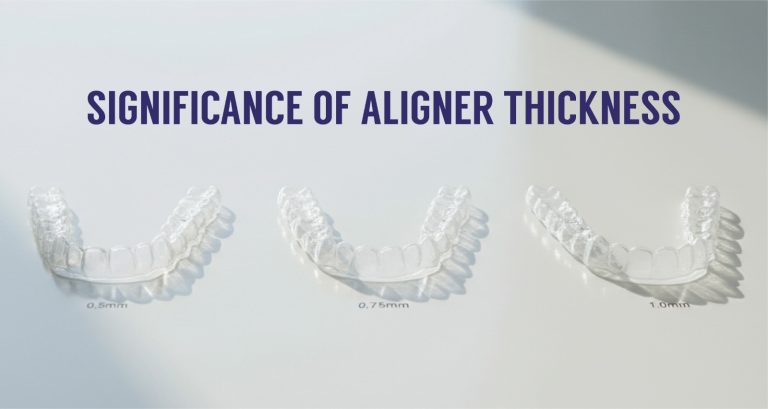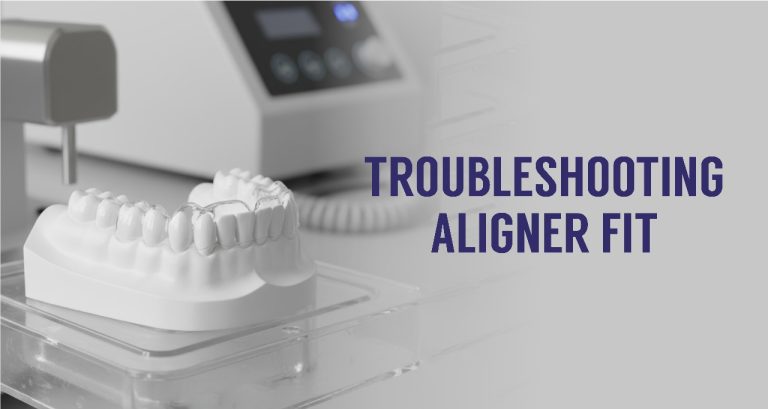Enquire Form
How to choose between 0.5, 0.75 and 1.0 mm aligner sheets?

Understanding Aligner Sheet Thickness:
Choosing Between 0.5 mm, 0.75 mm, and 1.0 mm Sheets
What determines the success of an aligner treatment? Most of you would agree that it is all about attaining predictable outcomes for patients. The journey to achieving successful treatment outcomes depends on a lot of factors, but choosing the right thickness of aligners is pivotal to achieving your aligner treatment goals. The final thickness of aligners determines the amount of force that will be applied to your teeth. Choosing from aligner thicknesses between 0.5 mm, 0.75 mm, and 1 mm can change everything: how much force the aligner delivers, how comfortable the patient feels, how long it lasts, and even how predictable the results are.
Choosing the right thickness for your aligner case is a crucial decision, one that separates good from great treatment outcomes. So, let’s learn more about it.
Significance of Aligner Thickness:
The thinner the aligners are, the lighter the forces would be, whereas thicker aligners generate more forces. When you need only minor tooth movement, thinner aligners of around 0.5 mm are usually sufficient. In the same situation, choosing thicker aligners can bring in unnecessary changes. For major bodily movements, thicker aligners of around 1 mm are preferred; lighter aligners would fail to bring in the necessary changes and prolong the treatment duration.
To further elaborate,
- Thinner sheets bend more easily and feel super comfortable.
- Thicker sheets are stronger and push harder on teeth.
- Somewhere in the middle, you get balance, strength, with comfort.
You can choose between 0.5 mm, 0.75 mm, and 1.0 mm sheets, depending on the case and phase of the treatment.
Also, remember to always factor in the reduction in the thickness of aligners post-thermoforming.
0.5 mm Sheets

Aligners made from 0.5 mm sheets generate light forces. They are soft, flexible, and extremely comfortable.
Indications:
- Mild crowding and spacing cases
- Finishing or refinement stages
- Initial treatment stages
- Minor tipping movements
- Sensitive patients
Aligners made from 0.5 mm sheets deliver gentle, precise forces which are ideal for subtle movements. It is important to keep in mind that because they are soft, the force fades faster. So, they should not be used for major tooth movements or long wear cycles.
0.75 mm Sheets
0.75 mm sheets can be used to make aligners, which are neither too strong nor too soft. They generate greater force as compared to a 0.5 mm sheet.
Indications:
- Anterior aligner retraction
- Most full-arch treatments
- Moderate crowding or spacing
- Cases with both anterior and posterior movements
0.75 mm sheets deliver a balance of flexibility and control. They push teeth efficiently without making patients feel excessive pressure that they would possibly feel while wearing thicker aligners.
They also hold up well for longer wear schedules/stages. This thickness gives predictable outcomes. The thermoforming experience is better as it doesn’t warp easily, and it gives a good fit with consistent force delivery.
1.0 mm Sheets
When you need power and durability, you go with 1.0 mm. They’re thicker, stiffer, and bring in complex bodily movements.
Indications:
- Complex tooth movements
- Large bodily shifts, torque, or expansion
- Strong-bite patients or bruxers
- Retainers meant for long-term use
They deliver higher force levels and stay stable even when worn for long durations. Great for those few stages in tough cases where you need more “push” force to bring in the desired tooth movement.
It is important to note that they may feel tight, slightly bulkier, and take a day or two for the patient to get used to.
Also, they are not ideal for finishing touches; they can overshoot minor movements or feel too rigid for fine detailing.
So, 1.0 mm sheets can be used to bring in major movements, and then you can switch to thinner aligner sheets for minor finishing.
How to Pick the Right One?
| Clinical Situation | Best Thickness | Why |
| Mild anterior crowding | 0.5 mm | Gentle and precise force for small corrections |
| Refinement or finishing | 0.5 mm | Flexible and fits beautifully for detailing |
| Moderate full-arch movements | 0.75 mm | Balanced force and comfort |
| Rotations and tipping | 0.75 mm | Strong enough to move, gentle enough to wear |
| Complex or bodily movements | 1.0 mm | Delivers higher control and stiffness |
| Bruxers or heavy chewers | 1.0 mm | More durable and resistant to cracks |
| Retainers (long-term wear) | 0.75–1.0 mm | Holds shape longer, less warping |
| Sensitive patients | 0.5–0.75 mm | Comfort first — keeps them compliant |
This table will clinically guide you in the right direction, but always remember to use your judgement and track your cases accurately to get the desired treatment outcome.
A Few Tips from Us:
- Keep a record of which thickness you used at each stage. You will thank yourself later when planning refinements.
- Don’t mix up materials mid-case unless you’re sure of the force difference; it can throw off movement predictability.
Conclusion:
Aligner thickness might look like just a technical detail, but it quietly decides how successful your treatment will be. A 0.5 mm sheet provides lighter movements. A 0.75 mm sheet gives you balance, and a 1.0 mm sheet gives you strength for major bodily movements. Sometimes it’s not about choosing one, it’s about sequencing them right. You can alternate your sheet thickness as per the required tooth movement.
Because in aligner therapy, control doesn’t come from software alone; it comes from understanding the material in your hands and how it behaves with your patient’s teeth.
Explore Taglus’ exclusive range of aligner and retainer sheets of varying thicknesses, available in different material types. To know more, contact us today.
Know More About Us
SignUp To Our Newsletter And Get To Know More About Taglus
Copyrights@taglus-2025
*Taglus is a trademark of Vedia Solutions









Leave a Reply